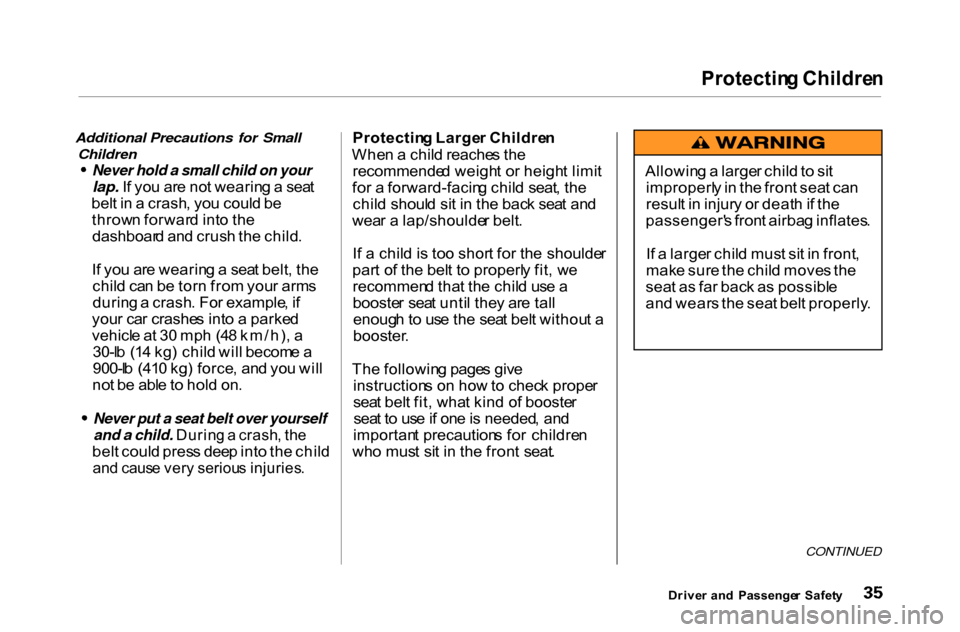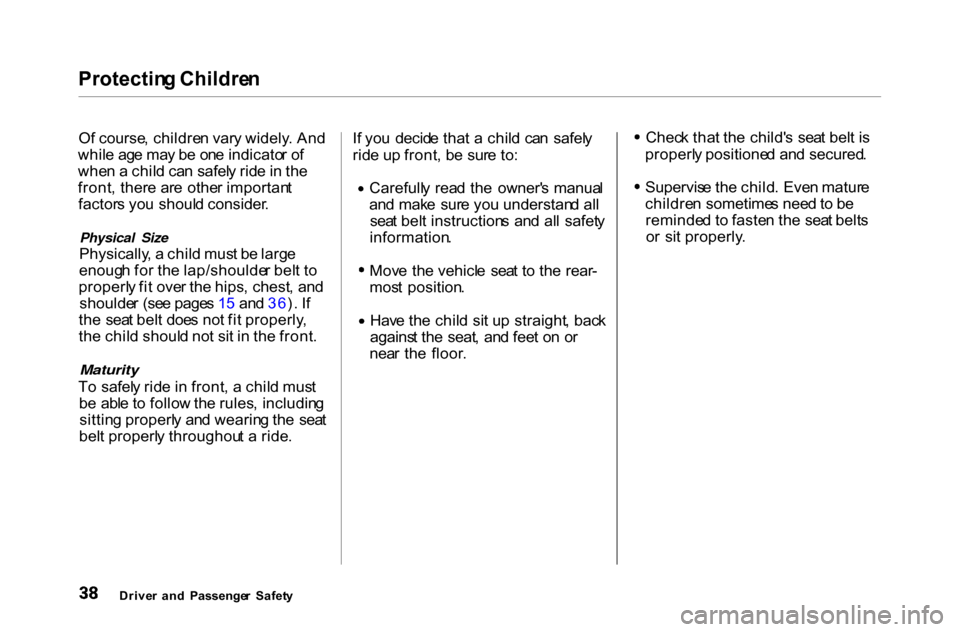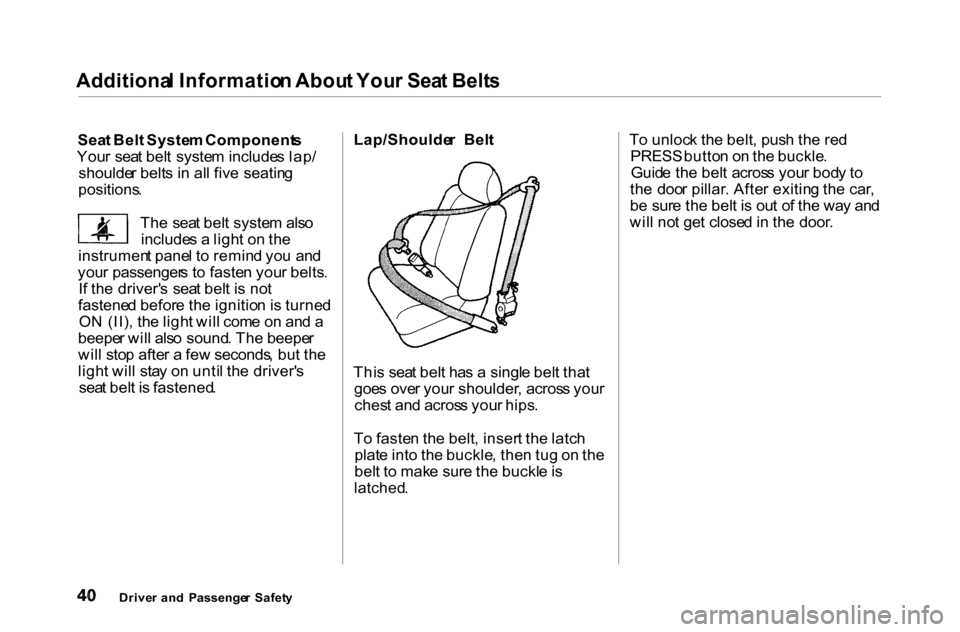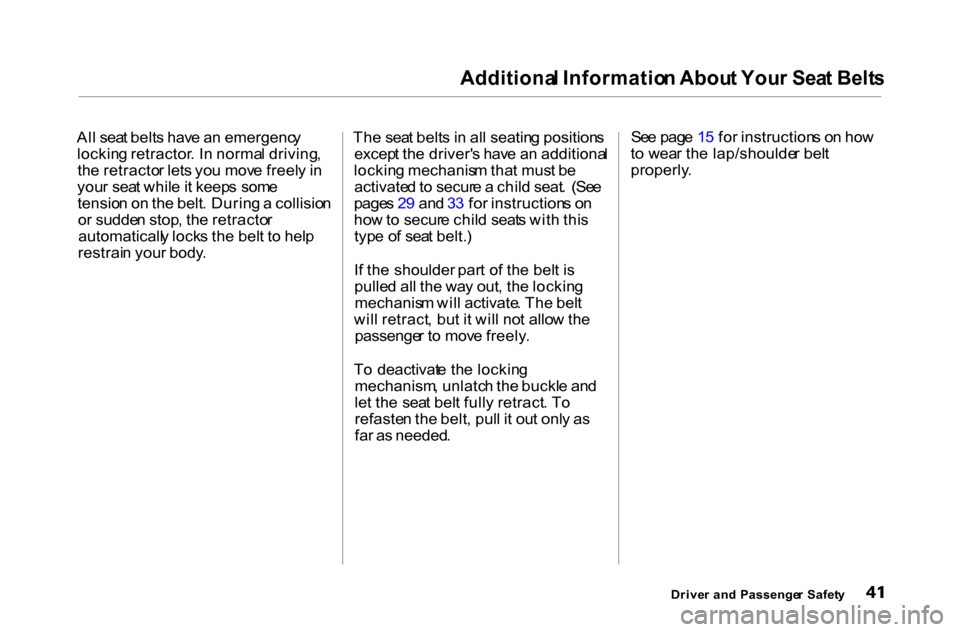2000 HONDA ACCORD COUPE belt
[x] Cancel search: beltPage 38 of 338

Protectin
g Childre n
Additional Precautions for Small Children
Never hold a small child on your
lap. I f yo u ar e no t wearin g a sea t
bel t i n a crash , yo u coul d b e
throw n forwar d int o th e
dashboar d an d crus h th e child .
I f yo u ar e wearin g a sea t belt , th e
chil d ca n b e tor n fro m you r arm s
durin g a crash . Fo r example , i f
you r ca r crashe s int o a parke d
vehicl e a t 3 0 mp h (4 8 km/h) , a
30-l b (1 4 kg ) chil d wil l becom e a
900-l b (41 0 kg ) force , an d yo u wil l
no t b e abl e to hol d on .
Never put a seat belt over yourself
and a child. Durin g a crash , th e
bel t coul d pres s dee p int o th e chil d
an d caus e ver y seriou s injuries .
Protectin
g Large r Childre n
Whe n a chil d reache s th e
recommende d weigh t o r heigh t limi t
fo r a forward-facin g chil d seat , th e
chil d shoul d si t i n th e bac k sea t an d
wea r a lap/shoulde r belt .
I f a chil d is to o shor t fo r th e shoulde r
par t o f th e bel t t o properl y fit , w e
recommen d tha t th e chil d us e a
booste r sea t unti l the y ar e tal l
enoug h to us e th e sea t bel t withou t a
booster .
Th e followin g page s giv e
instruction s o n ho w to chec k prope r
sea t bel t fit , wha t kin d o f booste r
sea t t o us e if on e is needed , an d
importan t precaution s fo r childre n
wh o mus t si t i n th e fron t seat .
CONTINUED
Drive r an d Passenge r Safet y
Allowin
g a large r chil d to si t
improperl y in th e fron t sea t ca n
resul t i n injur y o r deat h if th e
passenger' s fron t airba g inflates .
I f a large r chil d mus t si t i n front ,
mak e sur e th e chil d move s th e
sea t a s fa r bac k a s possibl e
an d wear s th e sea t bel t properly .
Page 39 of 338

Protectin
g Childre n
Checking Seat Belt Fit
T o determin e i f a lap/shoulde r bel t
properl y fit s a child , hav e th e chil d
pu t o n th e sea t belt . Follo w th e
instruction s o n pag e 1 5 . The n chec k
ho w th e bel t fits .
I f th e shoulde r par t o f th e bel t rest s
ove r th e child' s collarbon e an d
agains t th e cente r o f th e chest , a s
shown , th e chil d is larg e enoug h t o
wea r th e sea t belt . However
, i f th e bel t touche s o r
crosse s th e child' s neck , th e chil d
need s t o us e a booste r seat .
Do not let a child wear a seat belt
across the neck. Thi s coul d resul t i n
seriou s nec k injurie s durin g a crash .
Do not let a child put the shoulder
part of a seat belt behind the back or under the arm. Thi s coul d caus e
ver y seriou s injurie s durin g a crash .
I t als o increase s th e chanc e tha t th e
chil d wil l slid e unde r th e bel t i n a
cras h an d b e injured .
Do not put any accessories on a seat
belt. Device s intende d to improv e
occupan t comfor t o r repositio n th e
shoulde r par t o f a sea t belt , severel y
compromis e th e protectiv e capabilit y
o f th e sea t bel t an d increas e th e
chanc e o f seriou s injur y in a crash .
Two children should never use the
same seat belt. I f the y do , the y coul d
b e ver y seriousl y injure d in a crash .
Drive r an d Passenge r Safet y
Page 41 of 338

Protectin
g Childre n
O f course , childre n var y widely . An d
whil e ag e ma y b e on e indicato r o f
whe n a chil d ca n safel y rid e in th e
front , ther e ar e othe r importan t
factor s yo u shoul d consider .
Physical Size
Physically , a chil d mus t b e larg e
enoug h fo r th e lap/shoulde r bel t t o
properl y fi t ove r th e hips , chest , an d
shoulde r (se e page s 1 5 an d 36 ). I f
th e sea t bel t doe s no t fi t properly ,
th e chil d shoul d no t si t i n th e front .
Maturity
T o safel y rid e in front , a chil d mus t
b e abl e t o follo w th e rules , includin g
sittin g properl y an d wearin g th e sea t
bel t properl y throughou t a ride . I
f yo u decid e tha t a chil d ca n safel y
rid e u p front , b e sur e to :
Carefull y rea d th e owner' s manua l
an d mak e sur e yo u understan d al l
sea t bel t instruction s an d al l safet y
information .
Mov e th e vehicl e sea t t o th e rear -
mos t position .
Hav e th e chil d si t u p straight , bac k
agains t th e seat , an d fee t o n o r
nea r th e floor . Chec
k tha t th e child' s sea t bel t i s
properl y positione d an d secured .
Supervis e th e child . Eve n matur e
childre n sometime s nee d to b e
reminde d t o faste n th e sea t belt s
o r si t properly .
Drive r an d Passenge r Safet y
Page 43 of 338

Additiona
l Informatio n Abou t You r Sea t Belt s
Sea t Bel t Syste m Component s
You r sea t bel t syste m include s lap /
shoulde r belt s i n al l fiv e seatin g
positions .
Th e sea t bel t syste m als o
include s a ligh t o n th e
instrumen t pane l t o remin d yo u an d
you r passenger s t o faste n you r belts .
I f th e driver' s sea t bel t i s no t
fastene d befor e th e ignitio n is turne d
O N (II) , th e ligh t wil l com e o n an d a
beepe r wil l als o sound . Th e beepe r
wil l sto p afte r a fe w seconds , bu t th e
ligh t wil l sta y o n unti l th e driver' s
sea t bel t i s fastened . Lap/Shoulde
r Bel t
Thi s sea t bel t ha s a singl e bel t tha t
goe s ove r you r shoulder , acros s you r
ches t an d acros s you r hips .
T o faste n th e belt , inser t th e latc h
plat e int o th e buckle , the n tu g o n th e
bel t t o mak e sur e th e buckl e is
latched .
T
o unloc k th e belt , pus h th e re d
PRESS button o n th e buckle .
Guid e th e bel t acros s you r bod y t o
th e doo r pillar . Afte r exitin g th e car ,
b e sur e th e bel t i s ou t o f th e wa y an d
wil l no t ge t close d in th e door .
Drive r an d Passenge r Safet y
Page 44 of 338

Additiona
l Informatio n Abou t You r Sea t Belt s
Al l sea t belt s hav e a n emergenc y
lockin g retractor . I n norma l driving ,
th e retracto r let s yo u mov e freel y in
you r sea t whil e it keep s som e
tensio n o n th e belt . Durin g a collisio n
o r sudde n stop , th e retracto r
automaticall y lock s th e bel t t o hel p
restrai n you r body . Th
e sea t belt s in al l seatin g position s
excep t th e driver' s hav e a n additiona l
lockin g mechanis m tha t mus t b e
activate d to secur e a chil d seat . (Se e
page s 2 9 an d 3 3 fo r instruction s o n
ho w to secur e chil d seat s wit h thi s
typ e o f sea t belt. )
I f th e shoulder part o f th e bel t i s
pulle d al l th e wa y out , th e lockin g
mechanis m wil l activate . Th e bel t
wil l retract , bu t i t wil l no t allo w th e
passenge r t o mov e freely .
T o deactivat e th e lockin g
mechanism , unlatc h th e buckl e an d
le t th e sea t bel t full y retract . T o
refaste n th e belt , pul l i t ou t onl y a s
fa r a s needed . Se
e pag e 1 5 fo r instruction s o n ho w
t o wea r th e lap/shoulde r bel t
properly .
Drive r an d Passenge r Safet y
Page 45 of 338

Additiona
l Informatio n Abou t You r Sea t Belt s
Sea t Bel t Maintenanc e
Fo r safety , yo u shoul d chec k th e
conditio n o f you r sea t belt s regularly .
Pul l eac h bel t ou t full y an d loo k fo r
frays , cuts , burns , an d wear . Chec k
tha t th e latche s wor k smoothl y an d
tha t th e lap/shoulde r belt s retrac t
easily . An y bel t no t i n goo d conditio n
o r no t workin g properl y wil l no t
provid e goo d protectio n an d shoul d
b e replace d a s soo n a s possible .
U.S. Models
Hond a provide s a lifetim e
warrant y o n sea t belts . Hond a wil l
repai r o r replac e an y sea t bel t
componen t tha t fail s t o functio n
properl y durin g norma l use . Pleas e
se e you r Honda Warranty
Information bookle t fo r details . I
f a sea t bel t i s wor n durin g a crash ,
yo u shoul d hav e you r deale r inspec t
th e belt , an d replac e it i f necessary .
A bel t tha t ha s bee n wor n durin g a
cras h ma y no t provid e th e sam e leve l
o f protectio n in a subsequen t crash .
Th e deale r shoul d als o inspec t th e
anchor s fo r damag e an d replac e
the m if needed .
Fo r informatio n o n ho w to clea n you r
sea t belts , se e pag e 2 7 1.
Drive r an d Passenge r Safet y
No
t checkin g o r maintainin g
sea t belt s ca n resul t i n seriou s
injur y o r deat h i f th e sea t belt s
d o no t wor k properl y whe n
needed .
Chec k you r sea t belt s regularl y
an d hav e an y proble m
correcte d a s soo n a s possible .
Page 47 of 338

Additiona
l Informatio n Abou t You r Fron t Airbag s
Durin g a fronta l crash , you r sea t
belt s hel p restrai n you r lowe r bod y
an d torso . You r airba g provide s a
cushio n to hel p restrai n an d protec t
you r hea d an d chest .
Sinc e bot h airbag s us e th e sam e
sensors , bot h airbag s normall y
inflat e a t th e sam e time . However , i t
i s possibl e fo r onl y on e airba g to
inflate .
Thi s ca n occu r whe n th e severit y o f
a collisio n is a t th e margin , o r
threshold , tha t determine s whethe r
o r no t th e airbag s wil l deploy . I n
suc h cases , th e sea t bel t wil l provid e
sufficien t protection , an d th e
supplementa l protectio n offere d b y
th e airba g woul d b e minimal . Afte
r inflating , th e fron t airbag s
immediatel y deflate , s o the y won' t
interfer e wit h th e driver' s visibility ,
o r th e abilit y t o stee r o r operat e
othe r controls .
Th e tota l tim e fo r inflatio n an d
deflatio n is approximatel y one-tent h
o f a second , s o fas t tha t mos t
occupant s ar e no t awar e tha t th e
airbag s deploye d unti l the y se e the m
lyin g in thei r laps . Afte
r a crash , yo u ma y se e wha t
look s lik e smoke . Thi s is actuall y
powde r fro m th e airbag' s surface .
Althoug h th e powde r i s no t harmful ,
peopl e wit h respirator y problem s
ma y experienc e som e temporar y
discomfort . I f thi s occurs , ge t ou t o f
th e ca r a s soo n a s it i s saf e to d o so .
U.S. Owners
Fo r additiona l informatio n o n ho w
you r airbag s work , se e th e bookle t
title d SRS: What You Need to Know
About Airbags tha t cam e wit h you r
owner' s manual .
Canadian Owners
Fo r additiona l informatio n o n ho w
you r airbag s work , as k you r deale r
fo r a cop y o f th e bookle t title d SRS:
What You Need to Know About Airbags.
Drive r an d Passenge r Safet y
Page 49 of 338

Additiona
l Informatio n Abou t You r Sid e Airbag s
On all V6 models and the 4-cylinder EX
model with leather interior
You r ca r i s equippe d wit h sid e
airbag s fo r th e drive r an d a fron t
sea t passenger . Th e airbag s ar e
store d i n th e oute r edge s o f th e fron t
seat-backs , an d bot h ar e marke d
"SID E AIRBAG. " Ho
w You r Sid e Airbag s Wor k
I f yo u eve r hav e a moderat e t o
sever e sid e impact , th e sensor s wil l
detec t rapi d deceleratio n an d signa l
th e contro l uni t t o instantl y inflat e
eithe r th e driver' s o r th e passenger' s
sid e airbag .
Onl y on e airba g wil l deplo y durin g a
sid e impact . I f th e impac t i s o n th e
passenger' s side , th e passenger' s
sid e airba g wil l deplo y eve n if ther e
i s n o passenger . T
o ge t th e bes t protectio n fro m th e
sid e airbags , fron t sea t occupant s
shoul d wea r thei r sea t belt s an d si t
uprigh t an d wel l bac k i n thei r seats .
Drive r an d Passenge r Safet y